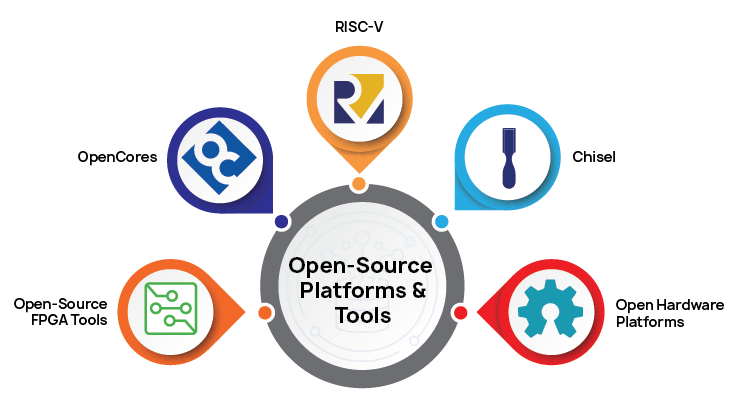

Acl Digital
5 Minutes read
Revolutionizing VLSI Design with RISC-V and Open-Source Hardware
The VLSI design landscape has long been defined by proprietary ecosystems dominated by closed Instruction Set Architectures (ISAs) and vendor-specific tools. While these solutions have historically optimized performance, they have significant drawbacks, such as limited customization, high costs, and barriers to entry for startups and academia. This restrictive approach has stifled innovation, creating a demand for more accessible and collaborative alternatives.
RISC-V and the open-source hardware movement have emerged as transformative forces in VLSI design, offering unprecedented flexibility and accessibility. By fostering transparency and global collaboration, these technologies democratize the semiconductor industry, paving the way for a more inclusive and innovative ecosystem.
Understanding RISC-V: The Open-Source ISA Revolution
RISC-V is a revolutionary open-source Instruction Set Architecture (ISA) free from licensing fees and proprietary constraints. Unlike traditional ISAs such as ARM and x86, RISC-V empowers engineers to design custom processors tailored to specific applications. Its open and modular design enables developers to innovate without the limitations imposed by vendor-locked ecosystems, benefiting from the contributions of a global community of experts.
Key Features of RISC-V
- Modularity and Simplicity: RISC-V’s streamlined base ISA supports diverse applications, from microcontrollers to supercomputers, with optional extensions for enhanced functionality.
- Open-Source Accessibility: RISC-V promotes transparency and collaborative development as an open standard, empowering organizations to innovate beyond proprietary ecosystems.
- Customizability: Developers can create application-specific processors by selectively incorporating extensions to optimize performance, power, or cost.
- Future-Proof Design: Forward compatibility ensures seamless adoption of future enhancements without disrupting existing implementations.
| Feature | RISC-V | ARM | x86 |
| Openness | Fully open-source; no royalties | Proprietary; licensed per use | Proprietary; closed ecosystem |
| Extensibility | Highly customizable, modular | Limited customization | Minimal extensibility |
| Ecosystem | Rapidly growing, open community | Well-established but controlled | Mature but restrictive |
| Target Applications | From IoT to HPC | Broad, constrained by licensing | HPC and general-purpose |
| Cost | Free to use | Licensing costs | Higher costs due to royalties |
RISC-V’s open-source nature revolutionizes VLSI design, providing unprecedented flexibility and fostering a collaborative and cost-efficient ecosystem. Its ability to democratize processor design challenges proprietary architectures and paves the way for innovations.
The Role of Open-Source Hardware in VLSI Design
Open-source hardware has emerged as a game-changer in VLSI (Very Large-Scale Integration) design, addressing longstanding challenges posed by proprietary ecosystems. Traditionally, VLSI design relied on closed systems with limited flexibility and high licensing costs, which constrained innovation, particularly for startups and academia. Open-source hardware, by contrast, fosters a collaborative environment that promotes transparency, scalability, and cost-efficiency.
- Enhanced Scalability and Reusability: Open-source hardware allows designers to reuse and adapt pre-existing designs for new applications, significantly reducing development time. Unlike proprietary systems, where pre-defined architectures restrict developers, open-source hardware enables modifications tailored to specific project requirements. For instance, an open-source IP core can be optimized for power efficiency in IoT devices or for high performance in AI accelerators, offering unparalleled scalability.
- Democratization of Access: By eliminating the need for expensive licenses and proprietary tools, open-source hardware opens the door to diverse contributors, from individual developers to large corporations. This inclusive approach enables organizations to experiment with innovative ideas without facing financial or intellectual property constraints. Academic institutions also benefit by using open-source platforms to train students on real-world designs, bridging the semiconductor engineering skills gap.
- Accelerated Time-to-Market: The availability of open-source IP cores, design libraries, and tools significantly reduces the development cycle. For example, pre-verified open-source components such as processor cores or memory controllers can be directly integrated into designs, enabling faster prototyping. This acceleration is particularly valuable in fast-evolving domains like AI and IoT, where reduced time-to-market is a critical competitive advantage.
- Fostering Innovation through Collaboration: Open-source hardware encourages a collaborative design approach. Engineers, researchers, and developers from around the globe contribute to improving existing designs or developing new ones. Platforms such as OpenCores and GitHub host repositories where designers can collaborate, share best practices, and develop cutting-edge solutions, paving the way for innovation at an unprecedented scale.
Notable Open-Source Platforms and Tools
Several platforms and tools have gained prominence in the open-source hardware domain, each playing a crucial role in reshaping VLSI design workflows

- RISC-V: The most transformative example of open-source hardware, RISC-V, is an open Instruction Set Architecture (ISA) that allows complete customization. Its modular design supports various applications, from low-power IoT devices to high-performance computing (HPC) systems. Contributions from major corporations like NVIDIA and SiFive and startups have propelled RISC-V into the mainstream. Today, RISC-V is an academic concept and a viable alternative to proprietary ISAs like ARM and x86, offering flexibility without compromising performance.
- OpenCores: OpenCores is one of the largest repositories of open-source IP cores. It provides a variety of components, from basic peripherals to complex processors, under open-source licenses. Engineers leverage these cores to develop cost-efficient and scalable designs. For instance, a startup designing an ASIC (Application-Specific Integrated Circuit) for a niche application can use OpenCores’ components to avoid developing every part from scratch.
- Open-Source FPGA Tools: The FPGA (Field Programmable Gate Array) ecosystem has also seen a surge in open-source tools. Platforms like Yosys (an open-source synthesis tool), GHDL (a VHDL simulator), and nextpnr (an FPGA place-and-route tool) have democratized access to FPGA design workflows. These tools allow designers to create and verify FPGA designs without proprietary software, significantly reducing costs.
- Chisel: Chisel, developed by UC Berkeley, is a hardware description language (HDL) designed for digital design at higher abstraction levels. Its integration with RISC-V projects has enabled more efficient and modular design methodologies, particularly in research and prototyping.
- Open Hardware Platforms: Projects like OpenTitan (a secure chip design for Root-of-Trust applications) and LibreSoC (a GPU-accelerated processor) showcase the potential of open-source hardware in advanced applications. These platforms emphasize security, performance, and openness, setting new benchmarks for innovation.
The Future of VLSI Design with RISC-V and Open-Source Hardware
The convergence of RISC-V and open-source hardware is redefining the future of VLSI design by making it more inclusive, efficient, and innovation-driven.
- Standardization and Interoperability: As the RISC-V ecosystem grows, efforts by organizations like RISC-V International are creating standardized specifications that ensure interoperability across different implementations. This standardization fosters a cohesive ecosystem where modular IP cores, tools, and design methodologies can seamlessly integrate, reducing compatibility issues and enabling faster development cycles.
- Advancements in Edge Computing and AI: Open-source hardware, particularly RISC-V, is playing a pivotal role in addressing the unique requirements of edge computing and AI applications. Customizable ISAs allow designers to create lightweight, power-efficient processors optimized for edge devices, such as smart sensors and IoT hubs. Similarly, AI accelerators based on RISC-V are tailored for workloads like inference and training, offering competitive performance at a fraction of the cost of proprietary solutions.
- Expanding Collaborative Ecosystems: Startups, academia, and industry leaders actively invest in collaborative platforms to further the open-source movement. For instance, academic institutions produce graduates well-versed in open-source methodologies, while startups are pioneering niche applications. Meanwhile, corporations fund open-source projects and contribute to IP repositories, recognizing the strategic value of shared innovation.
- Democratizing Innovation: By lowering entry barriers, RISC-V and open-source hardware democratize access to semiconductor technologies, allowing even small teams to innovate globally. Applications such as quantum computing, 5G infrastructure, and autonomous systems benefit significantly as open-source methodologies streamline the development of domain-specific solutions.
- Future Trends: As VLSI design becomes increasingly complex, integrating open-source hardware with AI-driven tools is set to be a key trend. AI can optimize design workflows, automate verification processes, and enhance power and thermal management, complementing the flexibility and scalability of open-source architectures like RISC-V.
About ACL Digital
RISC-V and open-source hardware are not just transforming VLSI design—they are redefining its future. By fostering collaboration, reducing costs, and enabling unprecedented customization, these technologies empower organizations to innovate rapidly and effectively. As adoption accelerates, the semiconductor industry is poised to enter an era of democratized design, unlocking the limitless potential for groundbreaking advancements.
At ACL Digital, we harness the transformative capabilities of RISC-V and open-source hardware to deliver cutting-edge semiconductor solutions. Our expertise spans custom processor design for IoT, AI, and edge computing, seamless open-source integration using platforms like OpenCores and FPGA tools, and strategic collaborations with semiconductor leaders. By combining advanced tools, scalable workflows, and deep domain expertise, we empower organizations to transition effortlessly into the open-source era, driving innovation and staying ahead of the curve.
Discover how ACL Digital can position your organization at the forefront of VLSI design advancements, enabling smarter, more competitive solutions for the future.



